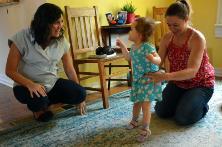 Here you will find resources, such as handouts, articles, video clips etc. related to supporting families of young children with gross and fine motor delays and associated disabilities.
Here you will find resources, such as handouts, articles, video clips etc. related to supporting families of young children with gross and fine motor delays and associated disabilities.
Motor Delays and Disabilities
Available Resources
Learn the Signs. Act Early. – Virginia Handouts (external website)
A series of handouts from the CDC’s Act Early campaign have been adapted for Virginia and are available on the Infant & Toddler Connection of Virginia website www.infantva.org. These handouts are available in English and Spanish and cover the following motor disabilities:
- Cerebral Palsy
- Duchenne Muscular Dystrophy
Other handouts are also available at the link above addressing topics such as autism, fragile X syndrome, hearing loss, etc.
Cerebral Palsy - NICHCY Disability Fact Sheet #2 (external website)
National Dissemination Center for Children with Disabilities
This fact sheet addresses a definition of CP, signs, types, treatment, and tips for parents and teachers.
Learn the Signs. Act Early. – Virginia Handouts (external website)
A series of handouts from the CDC’s Act Early campaign have been adapted for Virginia and are available on the Infant & Toddler Connection of Virginia website www.infantva.org. These handouts are available in English and Spanish and cover the following motor disabilities:
- Cerebral Palsy
- Duchenne Muscular Dystrophy
Other handouts are also available at the link above addressing topics such as autism, fragile X syndrome, hearing loss, etc.
Spina Bifida - NICHCY Disability Fact Sheet #12 (external website)
National Dissemination Center for Children with Disabilities
Kling, A., Campbell, P. H., & Wilcox, J. (2010). Young children with physical disabilities: Caregiver perspectives on assistive technology (external website). Infants & Young Children, 23(3), 169-183.
This study investigated the perspectives of caregivers of young children (average age 26 mo) with physical disabilities and noted the importance of using assistive technology and having early intervention providers who are knowledgeable and can provide training and support to families.
Hanna, K., & Rodger, S. (2002). Towards family-centred practice in paediatric occupational therapy: A review of the literature on parent-therapist collaboration (external website). Australian Occupational Therapy Journal, 49, 14-24.
This review of the literature addresses parent-therapist collaboration in the contexts of diversity, relationships, planning for intervention and service implementation.
Mahoney, G., Robinson, C., & Perales, F. (2004). Early Motor Intervention: The Need for New Treatment Paradigms. (external website, pdf) Infants & Young Children, 17(4), 291-300.
The authors of this article discuss recent study results and the larger context of literature related to treatment models for working with young children with motor impairments. According to the authors, recent study results indicated that contemporary approaches to treatment for this population are not meeting needs; this finding is consistent with current literature. The authors call for a renewed exploration of new treatment methods for working with infants and toddlers with motor disabilities.
Playtime for Children with Physical Disabilities (external website)
This article discusses the purpose of play, inclusion and adaptation, strategies for families, and play tips for ages newborn-1 year, 1-3 years, and 3-6 years.
Van Vlimmeren, L. A., Helders, P. J. M., Van Adrichem, & Engelbert, R. H. H. (2006, January). Torticollis and plagiocephaly in infancy: Therapeutic strategies (external website). Pediatric Rehabilitation, 9(1), 40-46.
This study highlights different treatment strategies for some of the most common asymmetries in infancy. Physical therapy, orthotic devices, and surgery are discussed.
Webinars
C.A.T.S.: We're Here to Help Kids Move, Play, and Communicate
VA’s Integrated Training Collaborative | Partnership for People with Disabilities
Presented by Melissa "Missy' Rose, PT, DPT, C/NDT
This webinar highlights the importance of access to durable medical equipment for families in early intervention. The Children's Assistive Technology Service (C.A.T.S.), which is a free service that makes recycled equipment available to support movement, adaptive play, and communication, is described and the type of equipment that is available is showcased.
Typical Motor Development 0-12 Months
VA’s Integrated Training Collaborative | Partnership for People with Disabilities
Presented by Missy Rose
This webinar describes typical motor development in the first year, red flags, and intervention strategies to encourage motor development. Click the link above to visit the 2012 Talks on Tuesdays Archive and scroll down until you find the webinar.
N/A
Toddler Development – Practice Clips
Desired Results Access Project – Video Library
Visit this video library for clips of toddlers participating in typical routines and activities. These videos were produced for use in professional development activities to provide early interventionists, early childhood educators, and other early care and education practitioners opportunities to practice skills such as observation, documentation, and assessment. You’ll find the following toddler clips in the Practice Clips section of the library:
- Tania Playing in the Yard (3:33) Tania demonstrates a variety of gross motor, communication, and social skills.
- Nicholas at Story Time (2:39) Nicholas demonstrates a variety of fine motor, social, and early literacy skills.
- Crystal Moving Around (3:26) Crystal demonstrates a variety of movement, social, and communication skills.
- Severina Plays Knock Knock (1:31) Severina demonstrates a variety of social, communication, and fine motor skills.
Pathways Videos (external website)
Pathways
Visit this site for many videos demonstrating infant and toddler development, milestones, parent guides for development, inspirational stories, and guidance for motor activities.
Cerebral Palsy: Hope through Research (external website)
National Institute of Neurological Disorders and Stroke
This site offers information about cerebral palsy related to causes, types, associated conditions, diagnosis, treatments, and research.
What Should you Know about Cerebral Palsy? (external website)
Centers for Disease Control
This site offers information about CP related to facts, causes, screening & diagnosis, data & statistics, research, articles, and links to other websites.